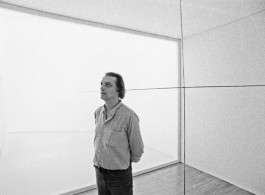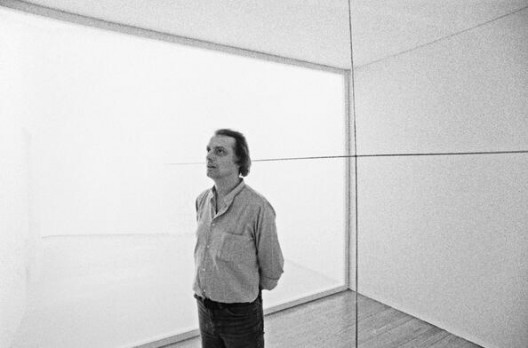Simon Lee Gallery, London
Simon Lee Gallery, in collaboration with the Archivio Luciano e Carla Fabro and Micheline Szwajcer, is proud to present a solo exhibition of historic works from the early 1960s by celebrated Italian artist Luciano Fabro (1936-2007), his first in London since his landmark show at the Tate Gallery in 1997. A leading figure in the landscape of post-war Italian art and proponent of the influential Arte Povera movement, Fabro is renowned for his radical practice that offered a re-evaluation of sculptural form via a rigorous approach to spatial context, material and meaning. Concerned with the environment of both work and viewer, the foundational theoretical works presented in this exhibition explore the framing of space with a spare and elegant simplicity designed to induct the viewer into a participatory experience, in which sensibility and seeing are symbiotic. Although later works by the artist employed sumptuous materials – silk, marble, bronze – Fabro’s first works encapsulate with economic means the experimental poetry that would come to define the conceptual innovation of his near five-decade long career.
The Metalli and Vetri are seminal works in Fabro’s artistic research, marking the initiation and embodying the essence of his investigation into modes of perception. A number of the works on show were presented at the artist’s first one-man exhibition at the Galleria Vismara, Milan, Italy in 1965 and testament to their central role within the trajectory of his practice, in 2001 he created a new edition of the metal sculptures. These works demonstrate a formal minimalism and narrative restraint that encourages a direct encounter between the space of the gallery, the space of the viewer and the space occupied by the object itself. He observed, ‘Just as a bent piece of iron expresses the force that was exerted upon it, just like a thrown stone gives a centre to the borders of a puddle, a finger indicates the direction of a gaze; in the same manner, we move in a space by means of solicitations of impressions’. Exploring the function of materials and forms in concrete space, the simple equations invoked by these works locate them within the physical and conceptual environment of the viewer, who encounters them both as sculpture and study. Defined by their own formal behaviour, they exist in flux, subject to their own material properties.
One of Fabro’s first works, Tubo da mettere tra i fiori (Tube to Place Among Flowers) (1963-2001) bridges the divide between the natural and the artificial, positioning the artist directly at the forefront of the Arte Povera movement. A metal bar placed amongst an assortment of plants appears to provide a sense of order lacking in the natural world. Yet with this sculpture Fabro elucidates the reciprocal relationship between art and nature, two opposed yet historically connected entities. Fabro continues to play with the viewer’s expectations of form in space in Ruota (Wheel) (1964-2001), in which a stainless steel circle is welded to an arm hinged from the wall of the gallery. The diameter of the arm is equal to the circumference of the hoop, which appears to roll towards the ground, thanks to the flexion of its support. The formal simplicity of Ruota is echoed in Croce (Cross) (1965-2001), a work that closely engages with the location in which it is installed. Interrogating the relationship between space and structure, the perpendicular angles of the metal cross sag, causing it to lunge precariously into the field of the viewer.
Two more works first conceived in 1965 see Fabro play with the perpendicular line. In Squadra (Square) (1965-2001) two tubular segments are fixed to each other at right angles, attached to the wall by the horizontal. Although rigorously square in advance of its installation, once in place its angles become obtuse as a result of the weight of the freestanding vertical rod. Asta (Pole) (1965-2001) is a metal pole that hangs from the ceiling, falling short of the floor by a few centimetres. Set at an incline of one degree from the perpendicular, in this deviation from the straight line the viewer finds a subtle movement, only distinguishable from certain positions. ‘The space’, noted Fabro, ‘amuses itself between the straight line and the curve’. In a later steel work of the same period, Contatto. Tautologia (1967-2001), a straight blade is fixed at either end of different walls. The viewer’s gaze is directed towards the middle of the pole, where it has been cut cleanly in two, leaving a noticeable divide.
Also included in the exhibition are four glass works from the 1960s that Fabro re-visited from 2004-2007 and which manifest a continuation of the artist’s early experiments with perception and illusion. The first work of this group, Buco (Hole) (1963-2005), is a sheet of mirrored glass decorated with a transparent design. At eye height the pattern gives way to a mirrored expanse, as though a hole in a net. The observer sees both reflection and transparency at once; two opposing spaces within a single frame. Tondo e rettangolo (Circle and Rectangle) (1964-2004) explores the inverse relation of a round mirror set within a transparent plane of glass to an adjacent transparent circle of the same proportions. Concerned with concurrent activities of reflection and revelation, the sculpture creates a contradictory site that denies the viewer any certain relationship with their field of vision. Mezzo specchiato mezzo trasparente (Half Mirrored Half Transparent) (1965-2007) demonstrates Fabro’s ongoing investigation into the interaction between reflection and non-reflection, culminating in the artist’s final work in this series: Tutto trasparente (All Transparent) (1965-2007). Of this entirely clear pane of glass, Fabro noted, ‘The material is neutral, it is the attention with which it is charged that transforms it’.




